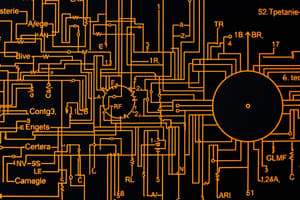Podcast
Questions and Answers
Who developed Boolean algebra?
Who developed Boolean algebra?
- George Boole (correct)
- Claude E. Shannon
- Isaac Newton
- Priti Sinha
What are the two possible values of Boolean equations?
What are the two possible values of Boolean equations?
0 and 1
Logical Addition is represented by the symbol '.'
Logical Addition is represented by the symbol '.'
False (B)
What operator is used for logical multiplication?
What operator is used for logical multiplication?
In which year did Claude E. Shannon propose using Boolean algebra for relay switching circuits?
In which year did Claude E. Shannon propose using Boolean algebra for relay switching circuits?
What is the symbol for complementation in Boolean algebra?
What is the symbol for complementation in Boolean algebra?
Boolean algebra deals with the ______ number system.
Boolean algebra deals with the ______ number system.
What is Boolean algebra primarily concerned with?
What is Boolean algebra primarily concerned with?
Who developed Boolean algebra?
Who developed Boolean algebra?
Which symbol represents logical addition in Boolean algebra?
Which symbol represents logical addition in Boolean algebra?
What does the symbol '.' represent in Boolean algebra?
What does the symbol '.' represent in Boolean algebra?
Boolean equations can only have three possible values.
Boolean equations can only have three possible values.
What year did Claude E. Shannon propose using Boolean algebra for designing relay switching circuits?
What year did Claude E. Shannon propose using Boolean algebra for designing relay switching circuits?
The logical operation that follows the law of binary addition is known as ______.
The logical operation that follows the law of binary addition is known as ______.
Match the following Boolean operators with their corresponding symbols:
Match the following Boolean operators with their corresponding symbols:
Flashcards are hidden until you start studying
Study Notes
Boolean Algebra and Logic Circuits
- Boolean Algebra is a system of mathematical logic used to express binary values (0 and 1).
- It was developed by English mathematician George Boole in the 19th century.
- Boolean Algebra is used to simplify the representation and manipulation of logical propositions.
- Claude Shannon proposed using Boolean Algebra in the design of relay switching circuits in 1938.
- Key concepts of Boolean Algebra:
- Binary Digit: Boolean equations only have two possible values: 0 and 1.
- Logical Addition (OR): Represented by the symbol '+', it follows the binary addition rules.
- Logical Multiplication (AND): Represented by the symbol '.', it follows the binary multiplication rules.
- Complementation (NOT): Represented by the symbol '-', it follows the binary complement rule.
- Boolean Algebra is widely used in electronic circuit design for computers due to its economical and straightforward approach.
Boolean Algebra
- Deals with binary number systems (0 and 1).
- Developed by George Boole (1815-1864) to simplify propositional logic.
- Used in designing relay switching circuits by Claude E. Shannon in 1938.
- Provides an economical and straightforward approach to designing electronic circuits used in computers.
Fundamental Concepts of Boolean Algebra
- Binary Digit: Boolean equations utilize binary digits (0 and 1).
- Logical Addition (OR): Represented by '+', performs binary addition.
- Logical Multiplication (AND): Represented by '.', performs binary multiplication.
- Complementation (NOT): Represented by ' - ', performs binary complement.
Studying That Suits You
Use AI to generate personalized quizzes and flashcards to suit your learning preferences.




